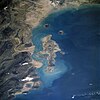Wikipedia:Today's featured article/February 10, 2013
The 2005 Qeshm earthquake was a powerful seismic event that occurred on November 27, 2005, on the sparsely populated Qeshm Island (pictured) off Southern Iran. It killed 13 people and devastated 13 villages. It was Iran's second major earthquake of 2005, following that at Zarand in February. The epicenter was about 1,500 kilometers (930 mi)* south of Tehran. The earthquake registered 5.8 on the moment magnitude scale. More than 400 minor aftershocks followed the main quake, 36 of which were greater than magnitude 2.5. The earthquake occurred in a remote area during the middle of the day, limiting the number of fatalities. Iranian relief efforts were effective and largely adequate, leading the country to decline offers of support from other nations and UNICEF. Qeshm Island is part of the Simply Folded Belt, the most seismically active part of the Zagros fold and thrust belt. Similar to most earthquakes in the area, the 2005 event resulted from reverse slip faulting. Since Iran lies in such a seismically active area, there is a high risk of destructive earthquakes; 1 in 3,000 deaths are attributable to earthquakes. One geophysicist has cited the lack of strict building codes as a serious concern. (Full article...)
Recently featured: Verpa bohemica – La Stazione – "Confirmed Dead"

